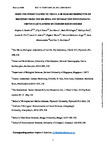FROM THE TORREY CANYON TO TODAY: A 50 YEAR RETROSPECTIVE OF RECOVERY FROM THE OIL SPILL AND INTERACTION WITH CLIMATE-DRIVEN FLUCTUATIONS ON CORNISH ROCKY SHORES
| dc.contributor.author | Hawkins, SJ | |
| dc.contributor.author | Evans, AJ | |
| dc.contributor.author | Moore, J | |
| dc.contributor.author | Whittington, M | |
| dc.contributor.author | Pack, K | |
| dc.contributor.author | Firth, Louise | |
| dc.contributor.author | Adams, LC | |
| dc.contributor.author | Moore, PJ | |
| dc.contributor.author | Masterson-Algar, P | |
| dc.contributor.author | Mieszkowska, N | |
| dc.contributor.author | Southward, EC | |
| dc.date.accessioned | 2022-04-29T10:34:57Z | |
| dc.date.available | 2022-04-29T10:34:57Z | |
| dc.date.issued | 2017-05-01 | |
| dc.identifier.issn | 2169-3366 | |
| dc.identifier.issn | 2169-3358 | |
| dc.identifier.uri | http://hdl.handle.net/10026.1/19120 | |
| dc.description.abstract |
<jats:title>ABSTRACT</jats:title> <jats:p>The Torrey Canyon was wrecked in 1967 with 117,000 tons of crude oil on board. The Plymouth Laboratory of the Marine Biological Association (MBA) of the UK was mobilized to deal with this environmental catastrophe. Many of the rocky shores affected by the spill and unaffected control sites had been studied by staff from the MBA, with A.J. and E.C. Southward charting fluctuations of rocky shore fauna and flora from the early 1950s – particularly barnacles – in relation to climate. Thus a baseline existed to help judge recovery of rocky shores from the beached oil and application of toxic first generation dispersants. A reminder is given of the initial acute impacts of the oil and its treatment by dispersants, and the first ten years of observations on recovery of shore communities. Subsequent follow-up work in the 1980s and 1990s suggested recovery took up to 15 years on the shore (Porthleven) subject to the most severe dispersant application. In contrast, recovery occurred in 2–3 years at Godrevy, a site where dispersants were not applied due to concerns about the impact on seals. The dispersants killed the dominant grazer, limpets of the genus Patella, leading to massive subsequent colonisation by seaweeds. The resulting canopy of fucoid algae (“rockweed” or “wrack”) facilitated dense recruitment of limpets. These subsequently grazed the seaweeds down, before the starving limpets largely died off after migrating across the shore in search of food. This reduction in limpet numbers and grazing pressure then prompted a further bloom of algae. There was then a return to normal levels of spatial and temporal variation of key species of seaweeds and limpets fluctuations charted at Porthleven from the mid 1980s to 2016. Comparisons are made with other oil spills for which long-term recovery has been assessed. Lessons learnt from observations stretching back 60 years, both before and after the spill, for rocky shore monitoring are highlighted – especially the need for broad-scale and long-term monitoring to separate out local impacts (such as oil spills) from global climate-driven change.</jats:p> | |
| dc.format.extent | 74-103 | |
| dc.language | en | |
| dc.language.iso | en | |
| dc.publisher | International Oil Spill Conference | |
| dc.title | FROM THE TORREY CANYON TO TODAY: A 50 YEAR RETROSPECTIVE OF RECOVERY FROM THE OIL SPILL AND INTERACTION WITH CLIMATE-DRIVEN FLUCTUATIONS ON CORNISH ROCKY SHORES | |
| dc.type | journal-article | |
| plymouth.issue | 1 | |
| plymouth.volume | 2017 | |
| plymouth.publication-status | Published | |
| plymouth.journal | International Oil Spill Conference Proceedings | |
| dc.identifier.doi | 10.7901/2169-3358-2017.1.74 | |
| plymouth.organisational-group | /Plymouth | |
| plymouth.organisational-group | /Plymouth/Faculty of Science and Engineering | |
| plymouth.organisational-group | /Plymouth/Faculty of Science and Engineering/School of Biological and Marine Sciences | |
| plymouth.organisational-group | /Plymouth/REF 2021 Researchers by UoA | |
| plymouth.organisational-group | /Plymouth/REF 2021 Researchers by UoA/UoA07 Earth Systems and Environmental Sciences | |
| plymouth.organisational-group | /Plymouth/Users by role | |
| plymouth.organisational-group | /Plymouth/Users by role/Academics | |
| dcterms.dateAccepted | 2017-01-01 | |
| dc.rights.embargodate | 2022-4-30 | |
| dc.identifier.eissn | 2169-3358 | |
| dc.rights.embargoperiod | Not known | |
| rioxxterms.versionofrecord | 10.7901/2169-3358-2017.1.74 | |
| rioxxterms.licenseref.uri | http://www.rioxx.net/licenses/all-rights-reserved | |
| rioxxterms.type | Journal Article/Review |


